
Utero-Vaginal Prolapse
SENIOR CONSULTANT
ASSIATANT PROFESSIOR
ISRAA HASHIM ABID ALKAREEM
FIOG.DOG.DHPE.

Background
• The pelvis encloses organs that primarily
function in storage, distension and evacuation.
The pelvic viscera must maintain their normal
anatomic relationships within this cavity so
that these physiological functions can be
sustained.

Background
The uterus is normally
anteverted,
anteflexed
Version:
is the angle between the
longitudinal axis of cervix, and that of the
vagina
Flexion:
is the angle between the
longitudinal axis of the uterus, and that of
the cervix

Genital Prolapse
• Genital prolapse
is the descent of one or more
of the genital organ (urethra, bladder, uterus,
rectum or Pouch of Douglas or rectouterine
pouch) through the fasciomuscular pelvic floor
below their normal level
• Vaginal prolapse
can occur without uterine
prolapse but the uterus cannot descend
without carrying the vagina with it.
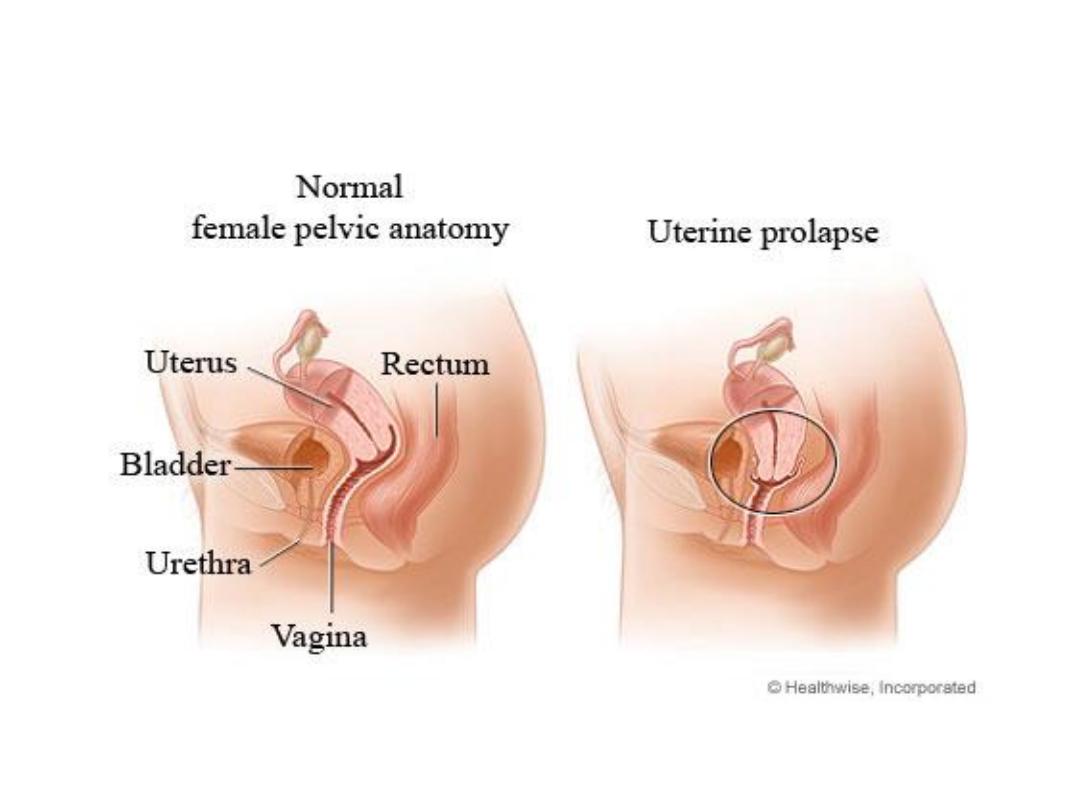

Supports of the uterus
• DeLancey in 1994 defined three levels of
vaginal support, reviving the importance of
the connective tissue structures and giving a
working basis for the present day
understanding of the anatomy and surgical
treatment.
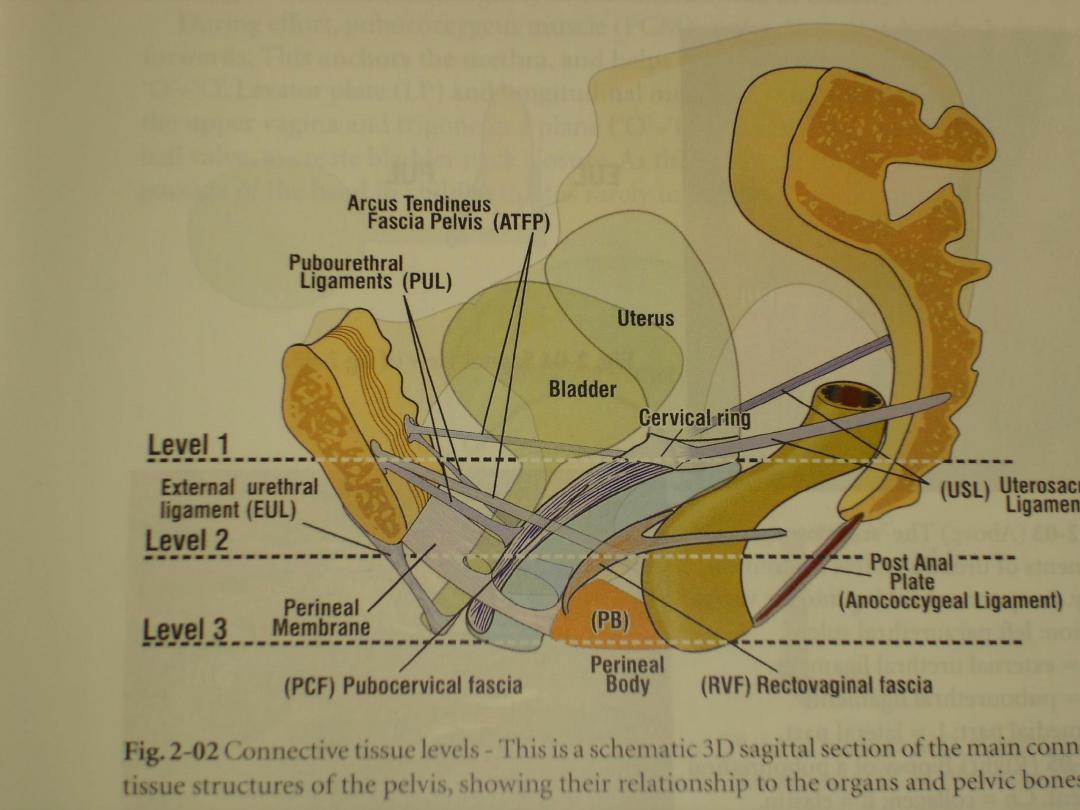

Three level of Supports of Uterus
• Level I: The cardinal uterosacral ligament
complex
• Level II: The pubo- cervical and recto-vaginal
fascia
• Level III: The pubo-urethral ligaments
anteriorly & the perineal body posteriorly

Anterior vaginal wall prolapse
• Prolapse of the upper part of the anterior
vaginal wall with the base of the bladder is
called
cystocele
• Prolapse of the lower part of the anterior
vaginal wall with the urethra is called
urethrocele.
• Complete anterior vaginal wall prolapse is
called
cysto-urethrocele.

Anterior vaginal wall prolapse
• Weakness in the
– Supports of the bladder neck
– Urethero vesical junction
– Proximal urethra
• Caused by
– Weakness of pubocervical fascia and
pubourethral ligaments


Middle compartment defect
• Enterocele and eversion of vagina
• Enterocele (Herniation of POD)

Posterior compartment defect
• Rectocele
• Perineal body descent
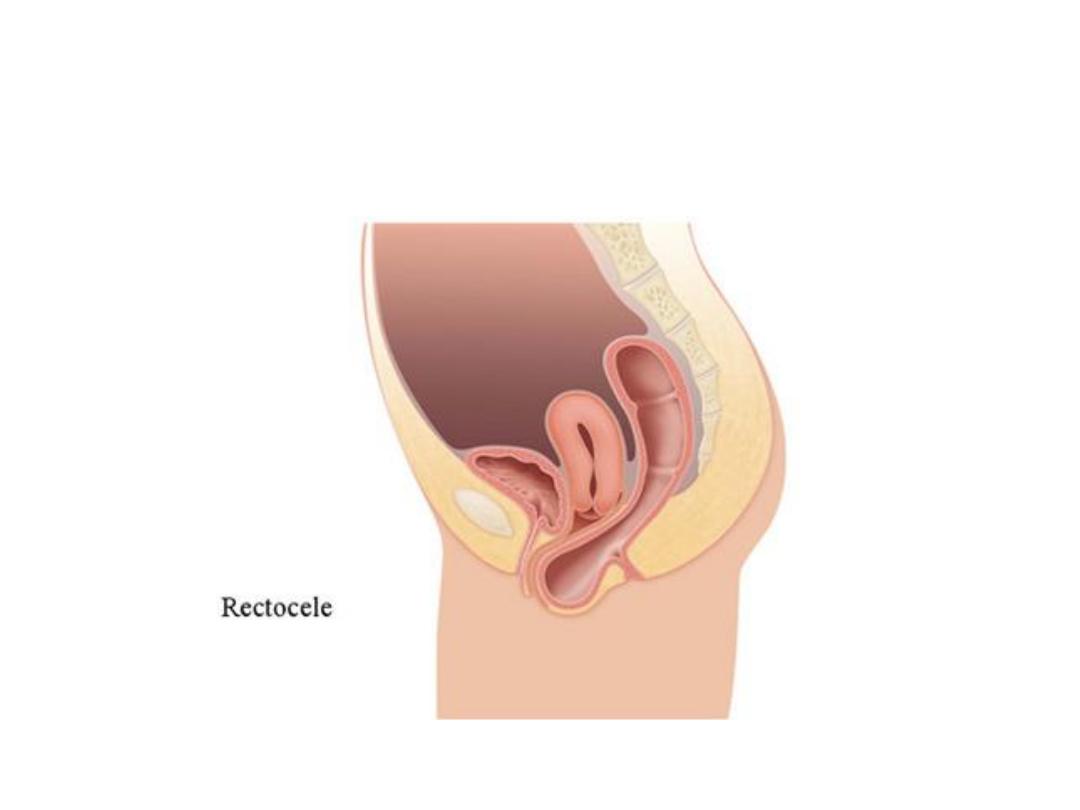

Uterine descent
• Utero-vaginal
(the uterus descends first
followed by the vagina): This usually occurs in
cases of virginal and nulliparous prolapse due
to congenital weakness of the cervical
ligaments.
• Vagino-uterine
(the vagina descends first
followed by the uterus):This usually occurs in
cases of prolapse resulting from obstetric
trauma.

Degree of uterine descent
• 1st degree:
The cervix desends below its
normal Ievel on straining but does not protrude
from the vulva (The extemal os of the cervix is
at the level of the ischial spines)
• 2nd degree
: The cervix reaches upto the vulva
on straining
• 3rd degree
: The cervix protrudes from the vulva
on straining
• Procidentia-
whole of the uterus is prolapsed
outside the vulva and the vaginal wall becomes
most completely inverted over it. Enterocele is
usually present
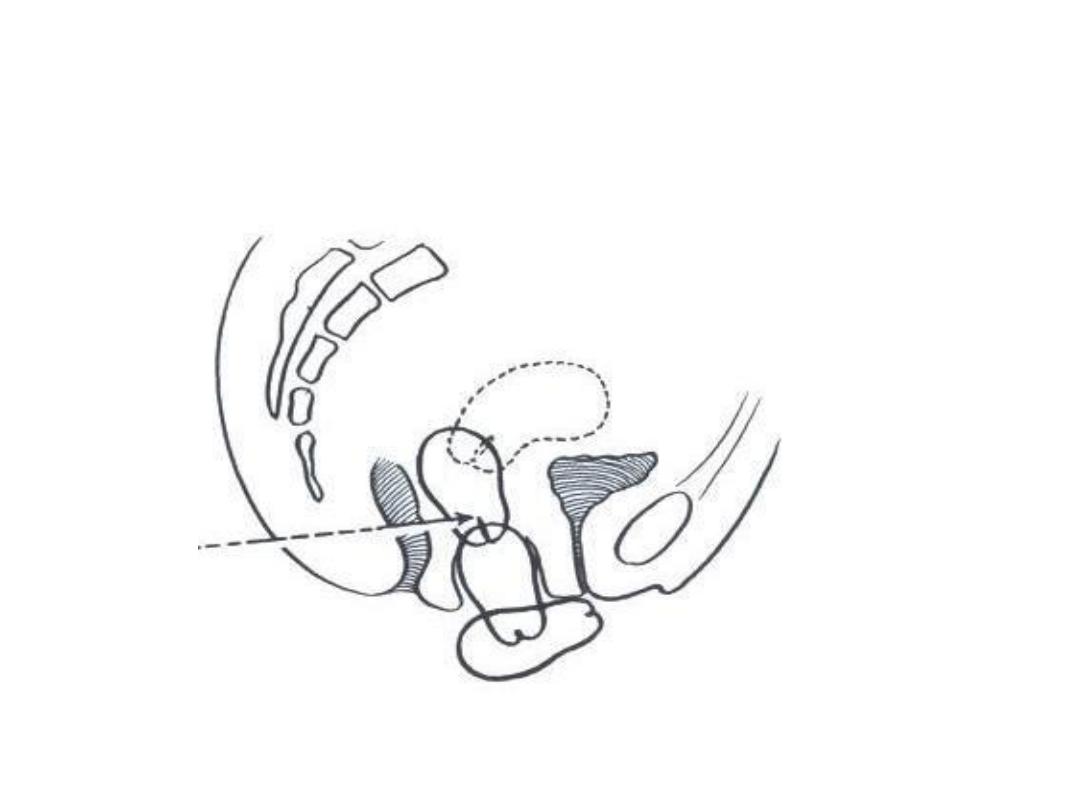
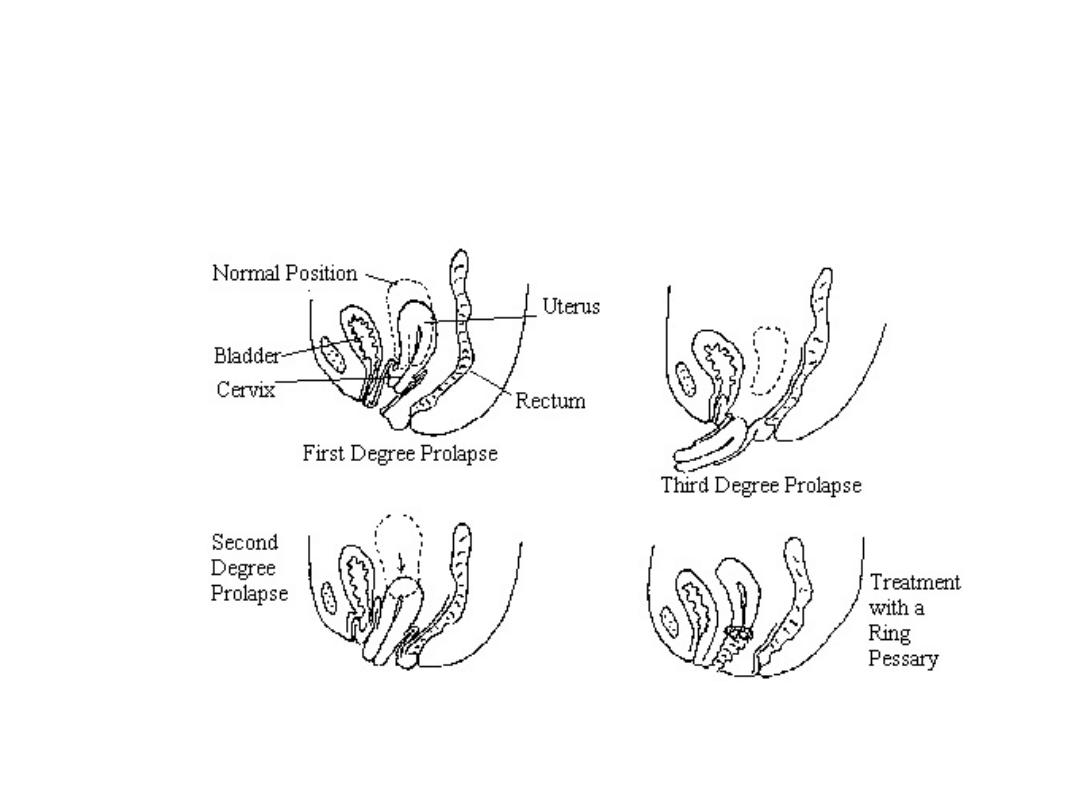

Vault prolapse
• Descent of the vaginal vault, where the top of
the vagina descends )or inversion of the
vagina) after hysterectomy
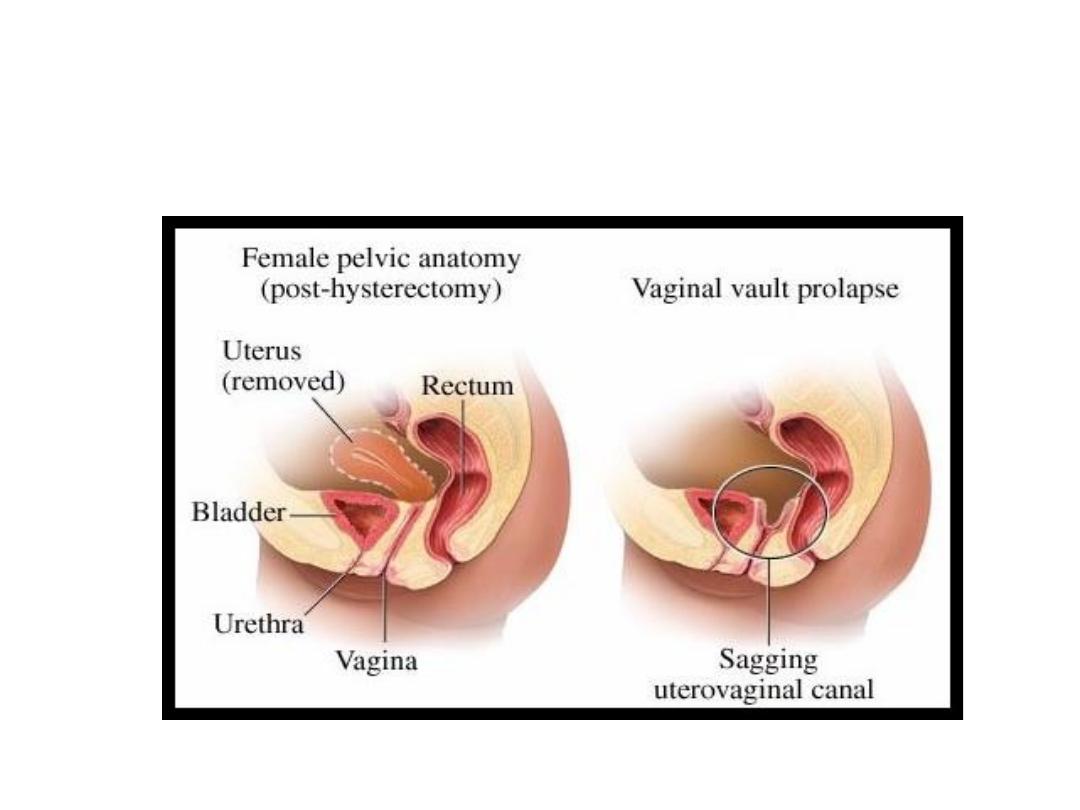

Pelvic organ prolapse quantitative
(POPQ) exam
• In 1996, by the ICS
• POPQ system describes the location and
severity of prolapse using segments of the
vaginal wall and external genitalia, rather than
the terms cystocele, rectocele, and enterocele

Aetiology
• Erect posture causes increased stress on muscles, nerves and
connective tissue
• Acute and chronic trauma of vaginal delivery
• Aging
• Estrogen deprivation
• Intrinsic collagen abnormalities
• Debilitation
• Iatrogenic

Precipitating factors
▪ ↑ intra abdominal pressure
▪ ↑ weight of the uterus
▪ Traction of the uterus by vaginal prolapse or by a large
cervical polyp
▪ Obesity(40%--75%)
▪ Smoking
▪ Pulmonary disease (chronic coughing)
▪ Constipation (chronic straining)
▪ Recreational or occupational activities
(frequent or heavy lifting)

Symptoms of Prolapse
• Pelvic floor disorders become symptomatic
through either of two mechanisms:
1. Mechanical difficulties produced by the
actual prolapse,
2. Bladder or bowel dysfunction, disrupting
either storage or emptying.

Clinical presentation
• Before actual prolapse. the patient
feels a sensation
of weakness in the perineum
. particularly towards
the end of the day
• Later the patient
notices a mass
which appears on
straining. and disappears when she lies down
• Urinary symptoms
are common and trouble some
even with slight prolapse:
a)
Urgency and frequency by day
b)
Stress incontinence
c)
Inability to micturate
unless the anterior vaginal
wall is pushed upwards by the patient's fingers
d)
Frequency
when
cystitis
develops

• Rectal symptoms
are not so marked. The patient always
feels heaviness in the rectum and a constant desire to
defaecate. Piles develop from straining.
• Backache, congestive dysmenorrhoea and menorrhagia
are common.
• Leucorrhoea
is caused by the congestion and associated
by chronic cervicitis.
• Associated
decubitus ulcer
may result in discharge which
may be purulent or blood stained

Diagnostic approach
• Beginning with a careful inspection of the
vulva and vagina to identify erosions,
ulcerations, or other lesions
• The extent of prolapse should be
systematically assessed
• Suspicious lesions should be biopsied

Examination
• Local examination
• Per speculum examination
• Per vaginal/ Bimanual examination
• Bonney’s stress test
• Evaluation of tone of pelvic muscles
• Recto vaginal examination
• Position of patient for examination
- standing & straining
- dorsal lithotomy

Diagnostic approach
• The maximal extent of prolapse is demonstrated with
a
standing straining examination
when the bladder is
empty
• Pelvic muscle function should be assessed after the
bimanual examination
→ palpate the pelvic muscles a
few centimeters inside the hymen, along pelvic
sidewalls at the 4 & 8 o’clock
• Resting tone & voluntary contraction of the anal
sphincters should be assessed during
rectovaginal
examination

Evaluation of pelvic floor tone
• Place 1 or 2 fingers in the vagina and instruct the
patient to contract her pelvic floor muscles (i.e., the
levator ani muscles). Then gauge her ability to contract
these muscles, as well as the strength, symmetry, and
duration of the contraction.
• The strength of the contraction can be subjectively
graded with a modified Oxford scale (0 = no
contraction, 1 = flicker, 2 = weak, 3 = moderate, 4 =
good, 5 = strong).

Bladder evaluation
• For all patients with prolapse following information
should be obtained
– Screening for urinary tract infection
– Postvoid residual urine volume
– Presence or absence of bladder sensation
• Bonney’s stress test performed following reduction
of prolapse
• If test positive incontinence surgery should be
performed at the time of prolapse surgery

Testing for Integrity of anal sphincter
• Should be assessed for resting tone and
voluntary squeeze and sensation around the
vulva with the bulbo-cavernous reflex and
crude sensory testing for evidence of
pudendal neuropathy

Prevention
• During labour &puerperium
– Avoid premature bearing down
– Avoid long second stage
– Repairs all tears &incisions accurately in layers
– Use delayed absorbable suture
– Do not express the uterus when attempting to
deliver placenta
– Encourage pelvic floor exercise
– Avoid puerperal constipation-decreases bearing
down

Prevention
• At hysterectomy
– Vault suspension with uterosacral and cardinal
ligaments
– Obliteration of deep cul-de –sac by Moschowitz
sutures
– Sacropexy in high risk situations like collagen
disorders
– Increase acceptability of estrogen replacement
therapy

Treatment
• Physiotherapy
– Kegel’s pelvic floor exercise
• Kegel’s perineometer
• Influence only the voluntary muscles
• No action to the fascial supporting system
– Vaginal cones of increasing weight .

Associated decubitus ulcer
• To relieve congestion, the prolapse can be
reposited in the vagina with the help of
tompoons ar pessary and this helps in healing
of the ulcer
• Hygroscopic agents like acriflavin-glycerine
can help reduce the congestion further

Pessary
• During pregnancy
• Immediately after pregnancy, during lactation
• When future childbearing is intended in near
future
• Refusal to operation by patient
• As a therapeutic test
• To promote healing in a decubital ulcer
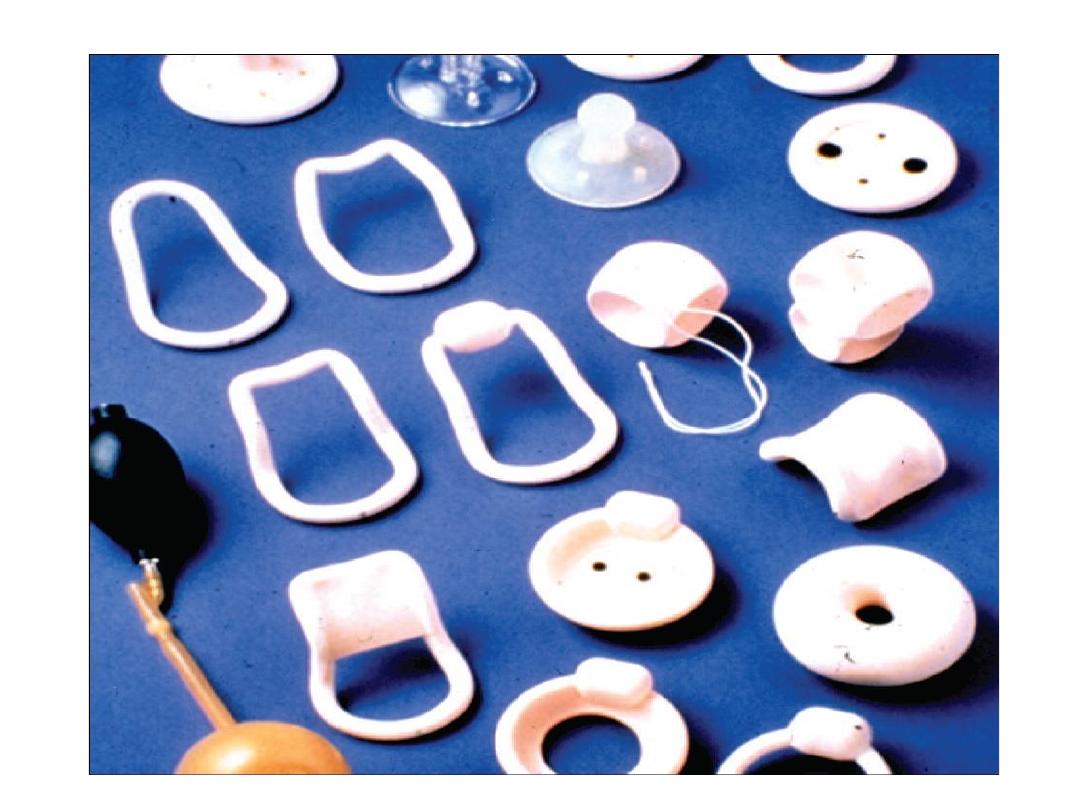

Pessary in situ

Complications of pessary
• Constipation
• Urinary incontinance
• B.vaginitis, ulceration of vaginal wall
• Cervicitis
• Carcinoma of vaginal wall
• Impaction of pessary
• Strangulation of prolapsed tissue

Principles of Management
• Physical examination must not be used in
isolation to develop treatment strategy.
• Any decision for surgical intervention
should take account of how prolapse is
affecting lifestyle.

Aim of pelvic reconstructive surgery
• To restore anatomy, maintain or restore
visceral function, and maintain or restore
normal sexual function

Uterine descent- surgeries
• Vaginal hysterectomy
• Sling surgeries
– Shirodkar
– Khanna’s
– Purandares
• Fothergill’s surgery

Vault prolapse
• Separation of the rectovaginal fascia from
pubocervical fascia.
• In post hysterectomy patients it is important
to reattach the rectovaginal fascia to the
pubocervical fascia and to provide good
support to the vaginal apex by reattaching the
vaginal cuff to the uterosacral cardinal
ligament complex.

Surgery for prolapsed vaginal vault
• Vaginal surgery
– Decreased operative time
– Decreased incidence of adhesion formation
– Quicker recovery time
• Abdominal surgery.
– Failed previous vaginal approach
– Have foreshortened vagina
– Young patients with advanced prolapse
– With other co existing conditions
• Obliterative procedures

Vaginal surgery
• Mc Call culdoplasty
– Internal
– external
• Sacrospinous ligament fixation
• High uterosacral ligament suspension with
fascial reconstruction
• Iliococcygeus fascia suspension

Abdominal repairs
• Abdominal sacral colpopexy
• High uterosacral ligament suspension
• Laparoscopic approach

Obliterative procedures
• Le forte partial colpocleisis
• Colpectomy and colpocleisis

Diagnosis of Stress Incontinence
with Pelvic Organ Prolapse
• Loss of urine during coughing, sneezing, laughing
or lifting something heavy
• These activities cause an increase in "belly
pressure” → forces the urine out of the bladder
• Stress incontinence occurs almost exclusively in
women & thought to be due to "pelvic (vaginal)
relaxation" from childbirth or aging

Treatment of Stress Incontinence
with Pelvic Organ Prolapse
• Conservative therapy
- Pelvic floor exercises
- Urinary meatel occlusion devices
- Collagen injections
• Urinary incontinence surgery
- Ant repair & Kelly’s plication
- Pubo-vaginal sling procedure
- TVT sling procedure
- Burch Urethropexy

Thank you
